Unit 17: Understanding and Leading Change: A Comprehensive Report
VerifiedAdded on 2022/12/27
|15
|5151
|424
Report
AI Summary
This report delves into the critical aspects of organizational change and leadership. It begins by comparing the impact of change across different organizations, using examples like Aldi and Hilton Hotels, highlighting how they adapted to shifts, particularly due to the COVID-19 pandemic. The report then evaluates the internal and external drivers of change, analyzing their influence on leadership, team dynamics, and individual behaviors, and discusses how these drivers affect companies like HSBC. It further examines measures to minimize the negative impacts of change, such as effective communication, the use of change models, and employee engagement. The report also explores the psychological impacts of change on individuals and teams, along with different models like the System theory, Continuous Improvement model and Burke Litwen model. Finally, it addresses barriers to change and different leadership approaches to manage change effectively, providing a comprehensive overview of the topic.
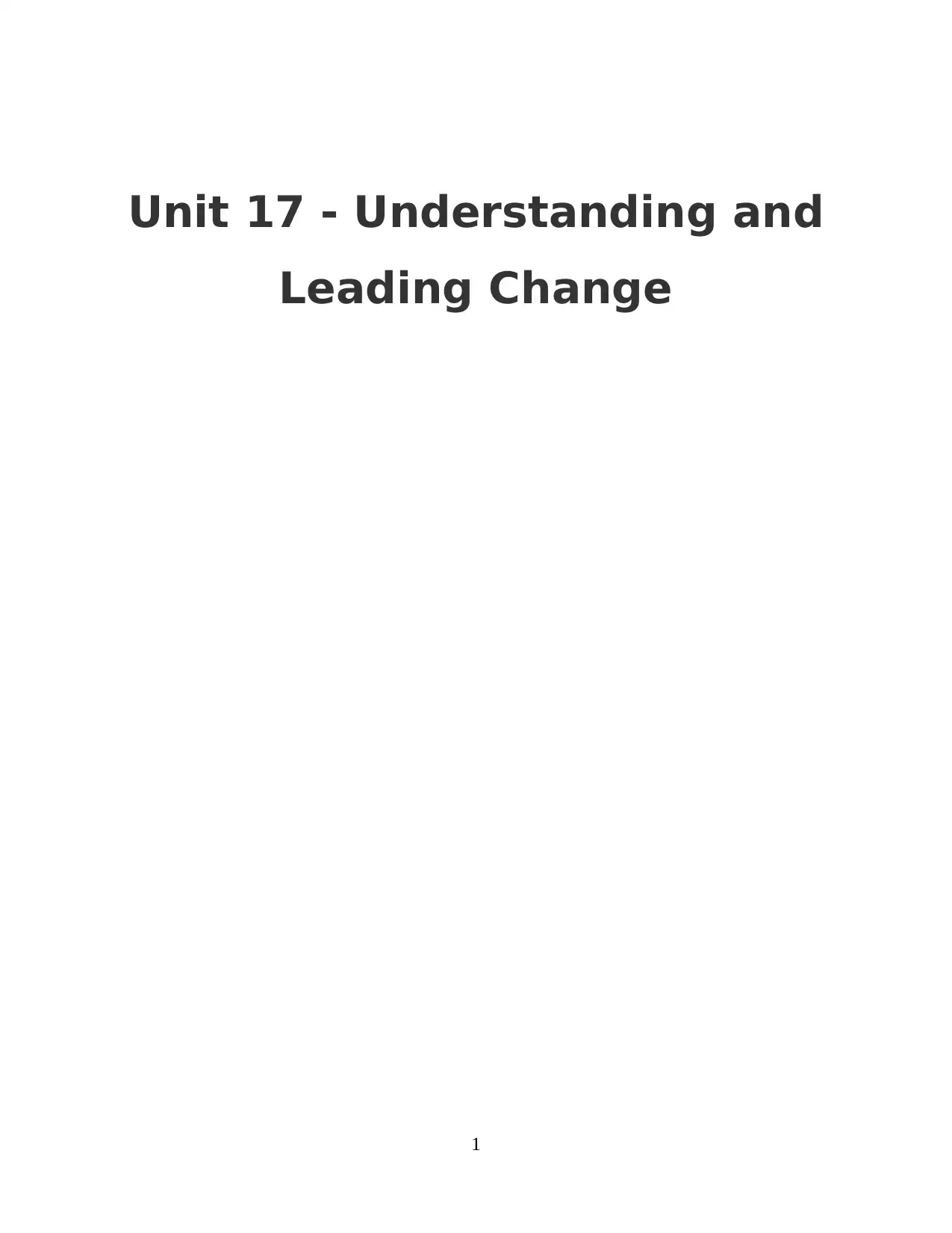
Unit 17 - Understanding and
Leading Change
1
Leading Change
1
Paraphrase This Document
Need a fresh take? Get an instant paraphrase of this document with our AI Paraphraser
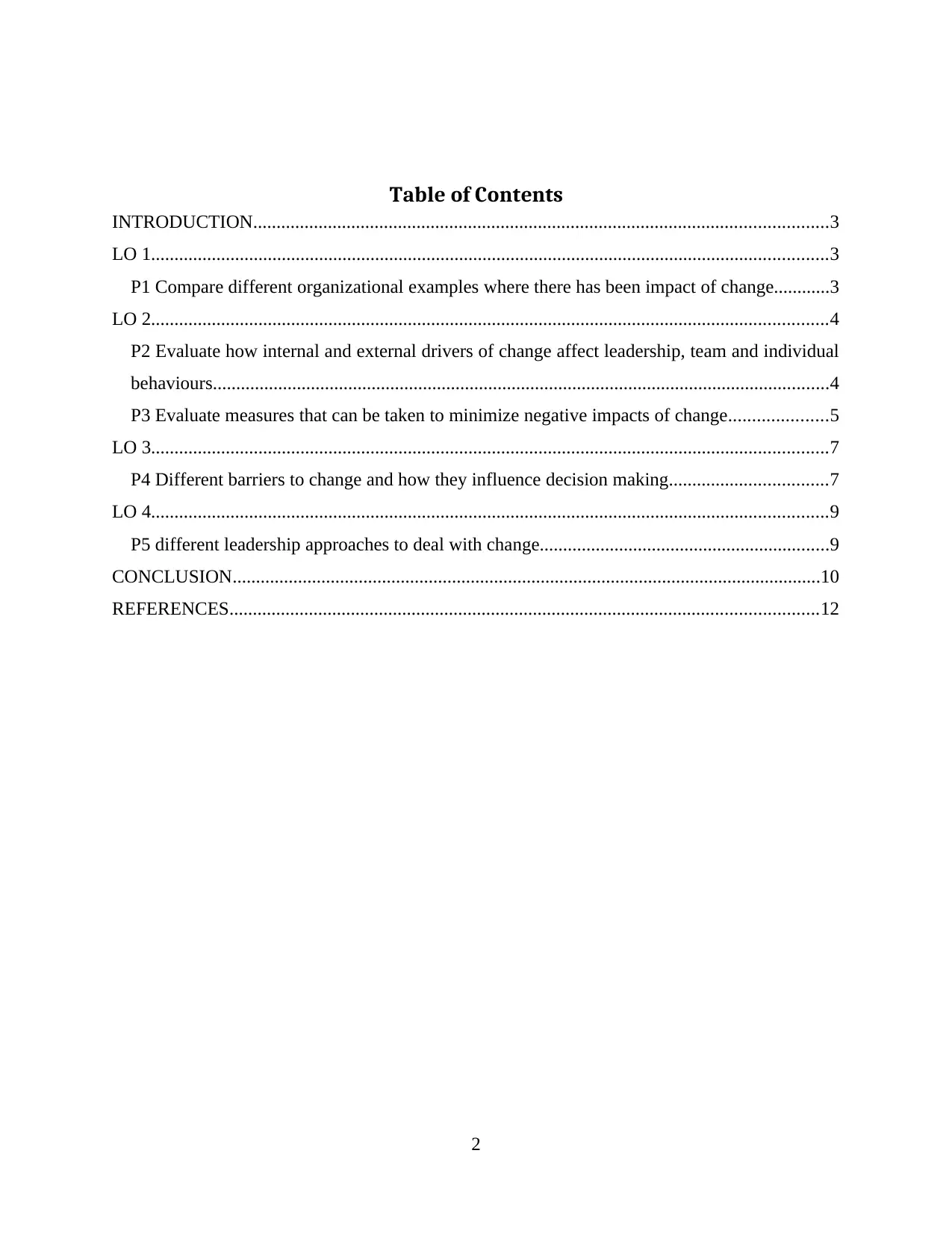
Table of Contents
INTRODUCTION...........................................................................................................................3
LO 1.................................................................................................................................................3
P1 Compare different organizational examples where there has been impact of change............3
LO 2.................................................................................................................................................4
P2 Evaluate how internal and external drivers of change affect leadership, team and individual
behaviours....................................................................................................................................4
P3 Evaluate measures that can be taken to minimize negative impacts of change.....................5
LO 3.................................................................................................................................................7
P4 Different barriers to change and how they influence decision making..................................7
LO 4.................................................................................................................................................9
P5 different leadership approaches to deal with change..............................................................9
CONCLUSION..............................................................................................................................10
REFERENCES..............................................................................................................................12
2
INTRODUCTION...........................................................................................................................3
LO 1.................................................................................................................................................3
P1 Compare different organizational examples where there has been impact of change............3
LO 2.................................................................................................................................................4
P2 Evaluate how internal and external drivers of change affect leadership, team and individual
behaviours....................................................................................................................................4
P3 Evaluate measures that can be taken to minimize negative impacts of change.....................5
LO 3.................................................................................................................................................7
P4 Different barriers to change and how they influence decision making..................................7
LO 4.................................................................................................................................................9
P5 different leadership approaches to deal with change..............................................................9
CONCLUSION..............................................................................................................................10
REFERENCES..............................................................................................................................12
2
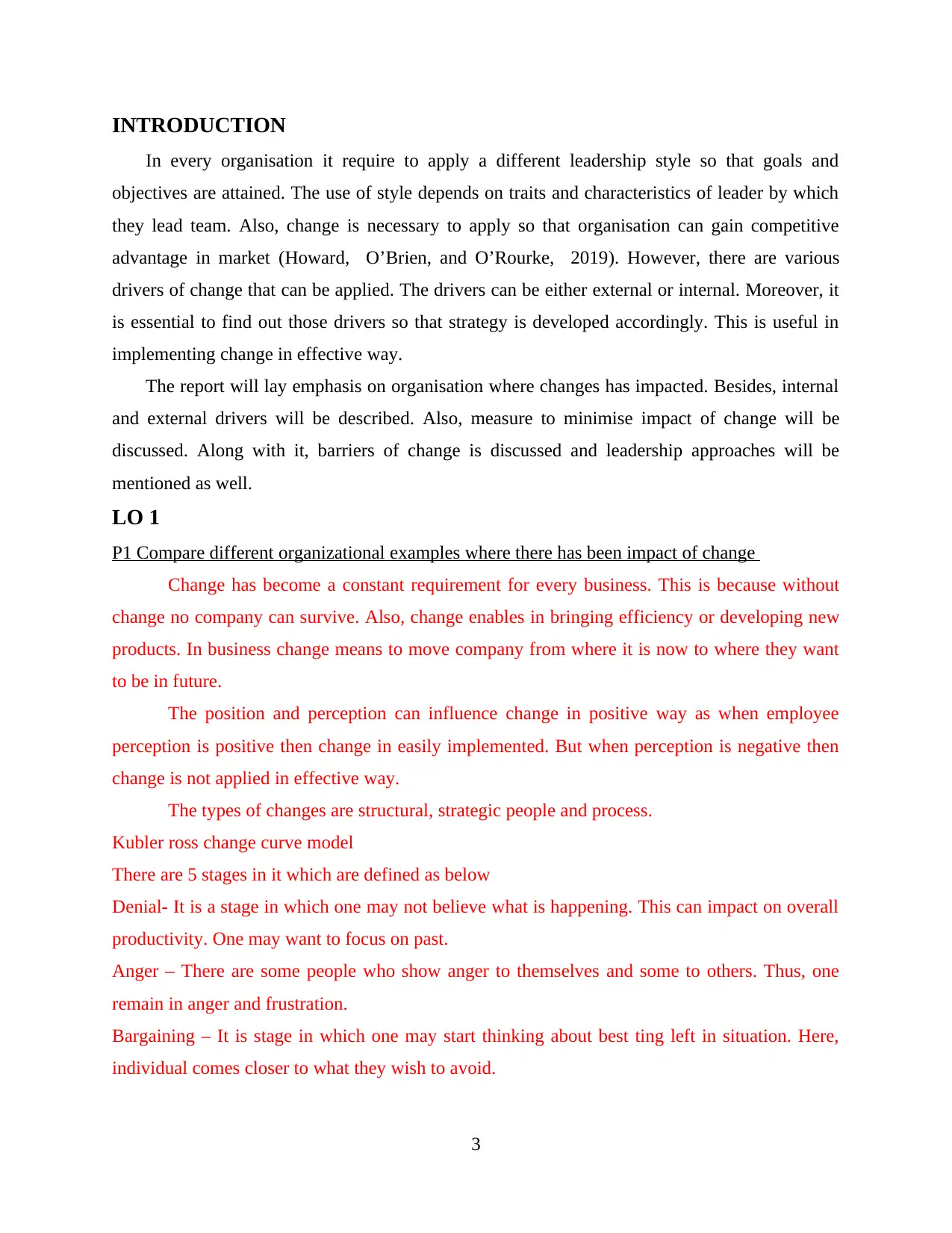
INTRODUCTION
In every organisation it require to apply a different leadership style so that goals and
objectives are attained. The use of style depends on traits and characteristics of leader by which
they lead team. Also, change is necessary to apply so that organisation can gain competitive
advantage in market (Howard, O’Brien, and O’Rourke, 2019). However, there are various
drivers of change that can be applied. The drivers can be either external or internal. Moreover, it
is essential to find out those drivers so that strategy is developed accordingly. This is useful in
implementing change in effective way.
The report will lay emphasis on organisation where changes has impacted. Besides, internal
and external drivers will be described. Also, measure to minimise impact of change will be
discussed. Along with it, barriers of change is discussed and leadership approaches will be
mentioned as well.
LO 1
P1 Compare different organizational examples where there has been impact of change
Change has become a constant requirement for every business. This is because without
change no company can survive. Also, change enables in bringing efficiency or developing new
products. In business change means to move company from where it is now to where they want
to be in future.
The position and perception can influence change in positive way as when employee
perception is positive then change in easily implemented. But when perception is negative then
change is not applied in effective way.
The types of changes are structural, strategic people and process.
Kubler ross change curve model
There are 5 stages in it which are defined as below
Denial- It is a stage in which one may not believe what is happening. This can impact on overall
productivity. One may want to focus on past.
Anger – There are some people who show anger to themselves and some to others. Thus, one
remain in anger and frustration.
Bargaining – It is stage in which one may start thinking about best ting left in situation. Here,
individual comes closer to what they wish to avoid.
3
In every organisation it require to apply a different leadership style so that goals and
objectives are attained. The use of style depends on traits and characteristics of leader by which
they lead team. Also, change is necessary to apply so that organisation can gain competitive
advantage in market (Howard, O’Brien, and O’Rourke, 2019). However, there are various
drivers of change that can be applied. The drivers can be either external or internal. Moreover, it
is essential to find out those drivers so that strategy is developed accordingly. This is useful in
implementing change in effective way.
The report will lay emphasis on organisation where changes has impacted. Besides, internal
and external drivers will be described. Also, measure to minimise impact of change will be
discussed. Along with it, barriers of change is discussed and leadership approaches will be
mentioned as well.
LO 1
P1 Compare different organizational examples where there has been impact of change
Change has become a constant requirement for every business. This is because without
change no company can survive. Also, change enables in bringing efficiency or developing new
products. In business change means to move company from where it is now to where they want
to be in future.
The position and perception can influence change in positive way as when employee
perception is positive then change in easily implemented. But when perception is negative then
change is not applied in effective way.
The types of changes are structural, strategic people and process.
Kubler ross change curve model
There are 5 stages in it which are defined as below
Denial- It is a stage in which one may not believe what is happening. This can impact on overall
productivity. One may want to focus on past.
Anger – There are some people who show anger to themselves and some to others. Thus, one
remain in anger and frustration.
Bargaining – It is stage in which one may start thinking about best ting left in situation. Here,
individual comes closer to what they wish to avoid.
3
⊘ This is a preview!⊘
Do you want full access?
Subscribe today to unlock all pages.

Trusted by 1+ million students worldwide
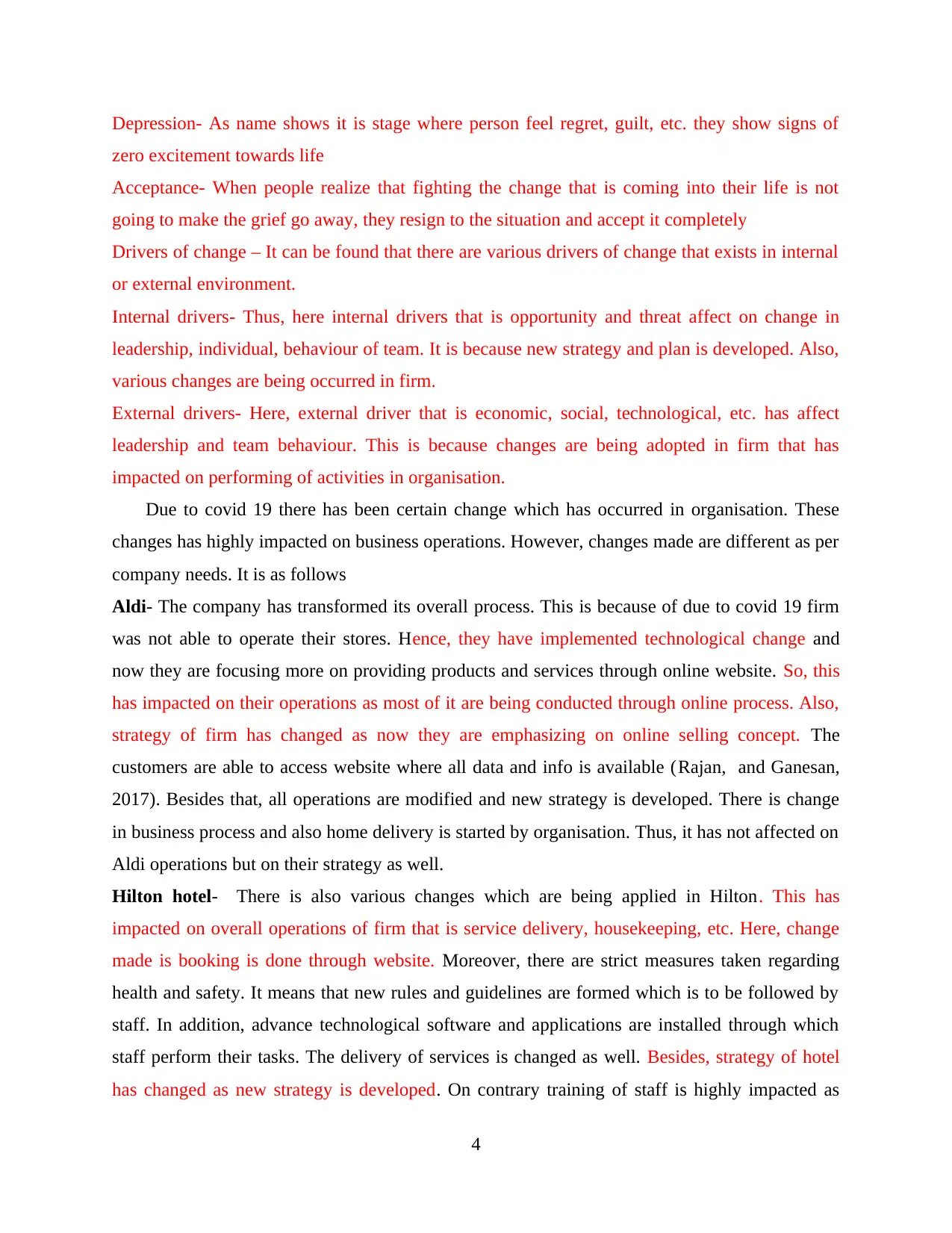
Depression- As name shows it is stage where person feel regret, guilt, etc. they show signs of
zero excitement towards life
Acceptance- When people realize that fighting the change that is coming into their life is not
going to make the grief go away, they resign to the situation and accept it completely
Drivers of change – It can be found that there are various drivers of change that exists in internal
or external environment.
Internal drivers- Thus, here internal drivers that is opportunity and threat affect on change in
leadership, individual, behaviour of team. It is because new strategy and plan is developed. Also,
various changes are being occurred in firm.
External drivers- Here, external driver that is economic, social, technological, etc. has affect
leadership and team behaviour. This is because changes are being adopted in firm that has
impacted on performing of activities in organisation.
Due to covid 19 there has been certain change which has occurred in organisation. These
changes has highly impacted on business operations. However, changes made are different as per
company needs. It is as follows
Aldi- The company has transformed its overall process. This is because of due to covid 19 firm
was not able to operate their stores. Hence, they have implemented technological change and
now they are focusing more on providing products and services through online website. So, this
has impacted on their operations as most of it are being conducted through online process. Also,
strategy of firm has changed as now they are emphasizing on online selling concept. The
customers are able to access website where all data and info is available (Rajan, and Ganesan,
2017). Besides that, all operations are modified and new strategy is developed. There is change
in business process and also home delivery is started by organisation. Thus, it has not affected on
Aldi operations but on their strategy as well.
Hilton hotel- There is also various changes which are being applied in Hilton. This has
impacted on overall operations of firm that is service delivery, housekeeping, etc. Here, change
made is booking is done through website. Moreover, there are strict measures taken regarding
health and safety. It means that new rules and guidelines are formed which is to be followed by
staff. In addition, advance technological software and applications are installed through which
staff perform their tasks. The delivery of services is changed as well. Besides, strategy of hotel
has changed as new strategy is developed. On contrary training of staff is highly impacted as
4
zero excitement towards life
Acceptance- When people realize that fighting the change that is coming into their life is not
going to make the grief go away, they resign to the situation and accept it completely
Drivers of change – It can be found that there are various drivers of change that exists in internal
or external environment.
Internal drivers- Thus, here internal drivers that is opportunity and threat affect on change in
leadership, individual, behaviour of team. It is because new strategy and plan is developed. Also,
various changes are being occurred in firm.
External drivers- Here, external driver that is economic, social, technological, etc. has affect
leadership and team behaviour. This is because changes are being adopted in firm that has
impacted on performing of activities in organisation.
Due to covid 19 there has been certain change which has occurred in organisation. These
changes has highly impacted on business operations. However, changes made are different as per
company needs. It is as follows
Aldi- The company has transformed its overall process. This is because of due to covid 19 firm
was not able to operate their stores. Hence, they have implemented technological change and
now they are focusing more on providing products and services through online website. So, this
has impacted on their operations as most of it are being conducted through online process. Also,
strategy of firm has changed as now they are emphasizing on online selling concept. The
customers are able to access website where all data and info is available (Rajan, and Ganesan,
2017). Besides that, all operations are modified and new strategy is developed. There is change
in business process and also home delivery is started by organisation. Thus, it has not affected on
Aldi operations but on their strategy as well.
Hilton hotel- There is also various changes which are being applied in Hilton. This has
impacted on overall operations of firm that is service delivery, housekeeping, etc. Here, change
made is booking is done through website. Moreover, there are strict measures taken regarding
health and safety. It means that new rules and guidelines are formed which is to be followed by
staff. In addition, advance technological software and applications are installed through which
staff perform their tasks. The delivery of services is changed as well. Besides, strategy of hotel
has changed as new strategy is developed. On contrary training of staff is highly impacted as
4
Paraphrase This Document
Need a fresh take? Get an instant paraphrase of this document with our AI Paraphraser
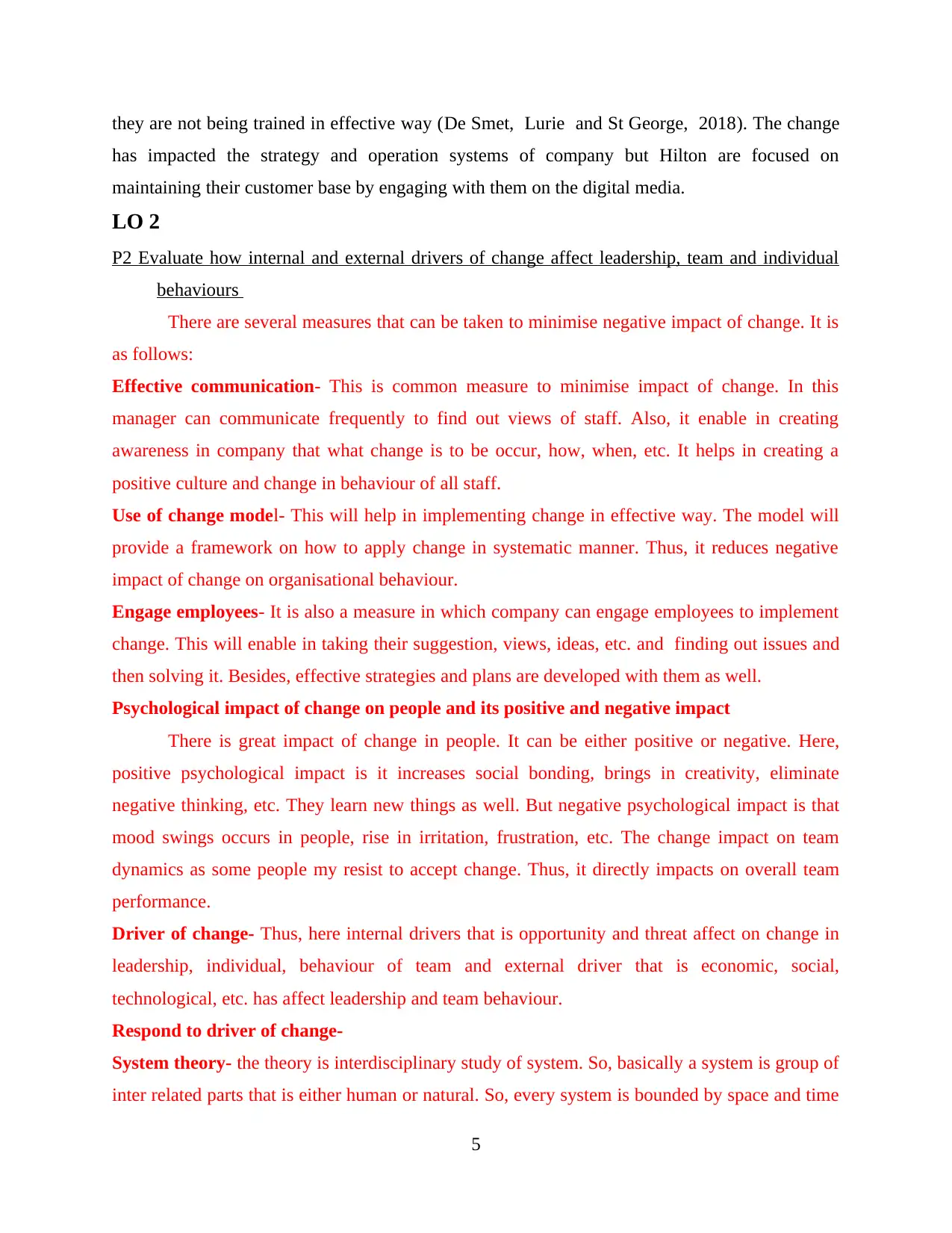
they are not being trained in effective way (De Smet, Lurie and St George, 2018). The change
has impacted the strategy and operation systems of company but Hilton are focused on
maintaining their customer base by engaging with them on the digital media.
LO 2
P2 Evaluate how internal and external drivers of change affect leadership, team and individual
behaviours
There are several measures that can be taken to minimise negative impact of change. It is
as follows:
Effective communication- This is common measure to minimise impact of change. In this
manager can communicate frequently to find out views of staff. Also, it enable in creating
awareness in company that what change is to be occur, how, when, etc. It helps in creating a
positive culture and change in behaviour of all staff.
Use of change model- This will help in implementing change in effective way. The model will
provide a framework on how to apply change in systematic manner. Thus, it reduces negative
impact of change on organisational behaviour.
Engage employees- It is also a measure in which company can engage employees to implement
change. This will enable in taking their suggestion, views, ideas, etc. and finding out issues and
then solving it. Besides, effective strategies and plans are developed with them as well.
Psychological impact of change on people and its positive and negative impact
There is great impact of change in people. It can be either positive or negative. Here,
positive psychological impact is it increases social bonding, brings in creativity, eliminate
negative thinking, etc. They learn new things as well. But negative psychological impact is that
mood swings occurs in people, rise in irritation, frustration, etc. The change impact on team
dynamics as some people my resist to accept change. Thus, it directly impacts on overall team
performance.
Driver of change- Thus, here internal drivers that is opportunity and threat affect on change in
leadership, individual, behaviour of team and external driver that is economic, social,
technological, etc. has affect leadership and team behaviour.
Respond to driver of change-
System theory- the theory is interdisciplinary study of system. So, basically a system is group of
inter related parts that is either human or natural. So, every system is bounded by space and time
5
has impacted the strategy and operation systems of company but Hilton are focused on
maintaining their customer base by engaging with them on the digital media.
LO 2
P2 Evaluate how internal and external drivers of change affect leadership, team and individual
behaviours
There are several measures that can be taken to minimise negative impact of change. It is
as follows:
Effective communication- This is common measure to minimise impact of change. In this
manager can communicate frequently to find out views of staff. Also, it enable in creating
awareness in company that what change is to be occur, how, when, etc. It helps in creating a
positive culture and change in behaviour of all staff.
Use of change model- This will help in implementing change in effective way. The model will
provide a framework on how to apply change in systematic manner. Thus, it reduces negative
impact of change on organisational behaviour.
Engage employees- It is also a measure in which company can engage employees to implement
change. This will enable in taking their suggestion, views, ideas, etc. and finding out issues and
then solving it. Besides, effective strategies and plans are developed with them as well.
Psychological impact of change on people and its positive and negative impact
There is great impact of change in people. It can be either positive or negative. Here,
positive psychological impact is it increases social bonding, brings in creativity, eliminate
negative thinking, etc. They learn new things as well. But negative psychological impact is that
mood swings occurs in people, rise in irritation, frustration, etc. The change impact on team
dynamics as some people my resist to accept change. Thus, it directly impacts on overall team
performance.
Driver of change- Thus, here internal drivers that is opportunity and threat affect on change in
leadership, individual, behaviour of team and external driver that is economic, social,
technological, etc. has affect leadership and team behaviour.
Respond to driver of change-
System theory- the theory is interdisciplinary study of system. So, basically a system is group of
inter related parts that is either human or natural. So, every system is bounded by space and time
5
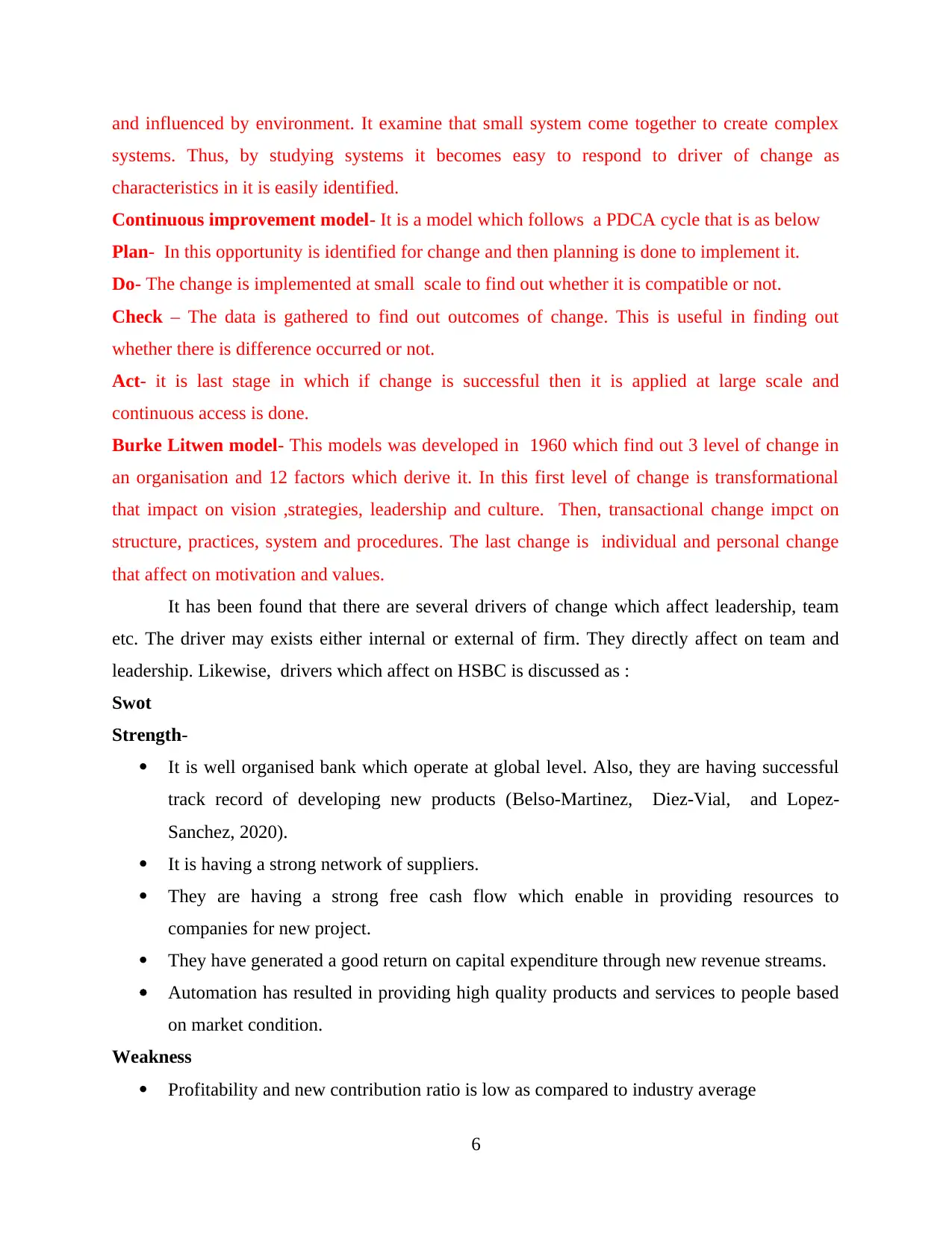
and influenced by environment. It examine that small system come together to create complex
systems. Thus, by studying systems it becomes easy to respond to driver of change as
characteristics in it is easily identified.
Continuous improvement model- It is a model which follows a PDCA cycle that is as below
Plan- In this opportunity is identified for change and then planning is done to implement it.
Do- The change is implemented at small scale to find out whether it is compatible or not.
Check – The data is gathered to find out outcomes of change. This is useful in finding out
whether there is difference occurred or not.
Act- it is last stage in which if change is successful then it is applied at large scale and
continuous access is done.
Burke Litwen model- This models was developed in 1960 which find out 3 level of change in
an organisation and 12 factors which derive it. In this first level of change is transformational
that impact on vision ,strategies, leadership and culture. Then, transactional change impct on
structure, practices, system and procedures. The last change is individual and personal change
that affect on motivation and values.
It has been found that there are several drivers of change which affect leadership, team
etc. The driver may exists either internal or external of firm. They directly affect on team and
leadership. Likewise, drivers which affect on HSBC is discussed as :
Swot
Strength-
It is well organised bank which operate at global level. Also, they are having successful
track record of developing new products (Belso-Martinez, Diez-Vial, and Lopez-
Sanchez, 2020).
It is having a strong network of suppliers.
They are having a strong free cash flow which enable in providing resources to
companies for new project.
They have generated a good return on capital expenditure through new revenue streams.
Automation has resulted in providing high quality products and services to people based
on market condition.
Weakness
Profitability and new contribution ratio is low as compared to industry average
6
systems. Thus, by studying systems it becomes easy to respond to driver of change as
characteristics in it is easily identified.
Continuous improvement model- It is a model which follows a PDCA cycle that is as below
Plan- In this opportunity is identified for change and then planning is done to implement it.
Do- The change is implemented at small scale to find out whether it is compatible or not.
Check – The data is gathered to find out outcomes of change. This is useful in finding out
whether there is difference occurred or not.
Act- it is last stage in which if change is successful then it is applied at large scale and
continuous access is done.
Burke Litwen model- This models was developed in 1960 which find out 3 level of change in
an organisation and 12 factors which derive it. In this first level of change is transformational
that impact on vision ,strategies, leadership and culture. Then, transactional change impct on
structure, practices, system and procedures. The last change is individual and personal change
that affect on motivation and values.
It has been found that there are several drivers of change which affect leadership, team
etc. The driver may exists either internal or external of firm. They directly affect on team and
leadership. Likewise, drivers which affect on HSBC is discussed as :
Swot
Strength-
It is well organised bank which operate at global level. Also, they are having successful
track record of developing new products (Belso-Martinez, Diez-Vial, and Lopez-
Sanchez, 2020).
It is having a strong network of suppliers.
They are having a strong free cash flow which enable in providing resources to
companies for new project.
They have generated a good return on capital expenditure through new revenue streams.
Automation has resulted in providing high quality products and services to people based
on market condition.
Weakness
Profitability and new contribution ratio is low as compared to industry average
6
⊘ This is a preview!⊘
Do you want full access?
Subscribe today to unlock all pages.

Trusted by 1+ million students worldwide
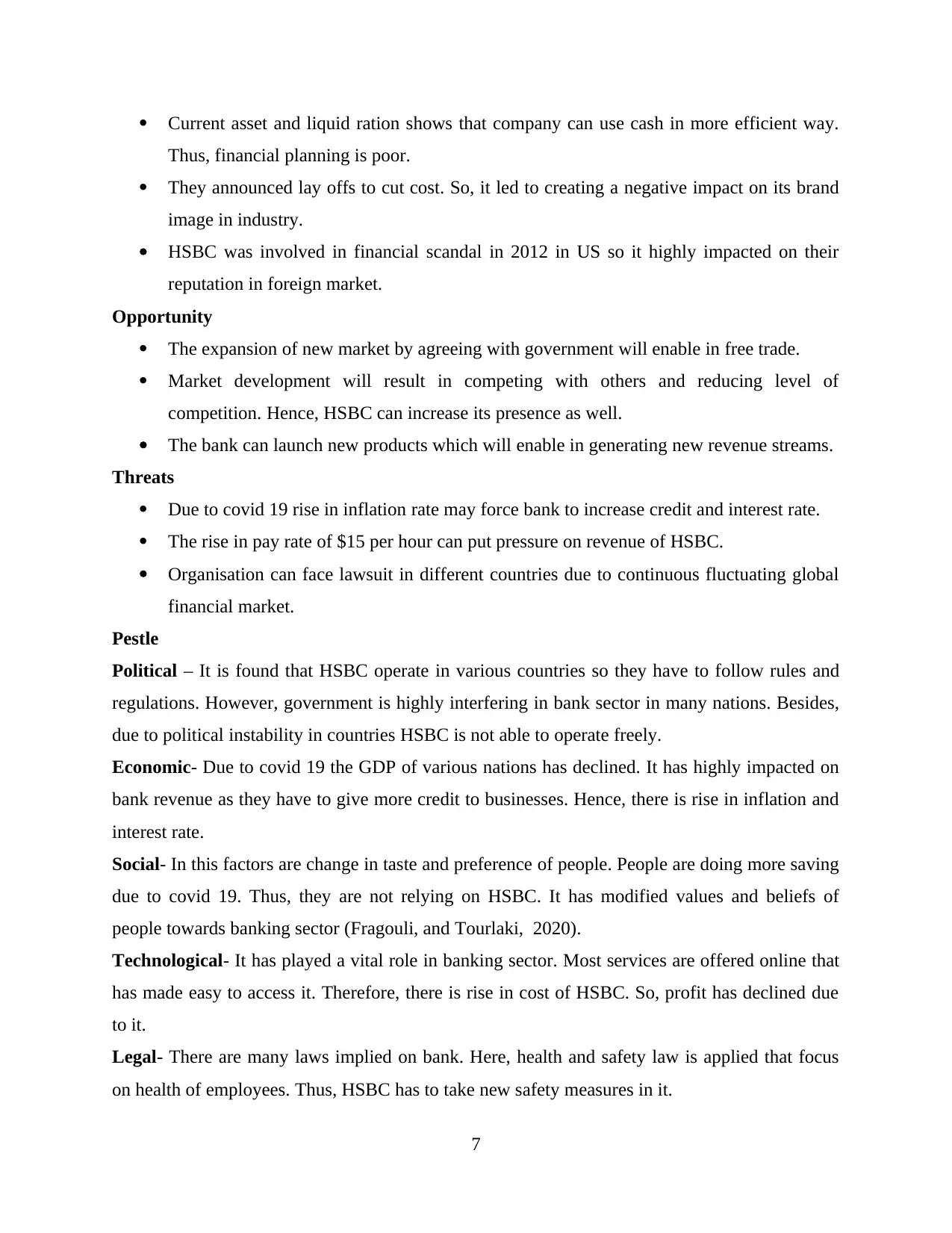
Current asset and liquid ration shows that company can use cash in more efficient way.
Thus, financial planning is poor.
They announced lay offs to cut cost. So, it led to creating a negative impact on its brand
image in industry.
HSBC was involved in financial scandal in 2012 in US so it highly impacted on their
reputation in foreign market.
Opportunity
The expansion of new market by agreeing with government will enable in free trade.
Market development will result in competing with others and reducing level of
competition. Hence, HSBC can increase its presence as well.
The bank can launch new products which will enable in generating new revenue streams.
Threats
Due to covid 19 rise in inflation rate may force bank to increase credit and interest rate.
The rise in pay rate of $15 per hour can put pressure on revenue of HSBC.
Organisation can face lawsuit in different countries due to continuous fluctuating global
financial market.
Pestle
Political – It is found that HSBC operate in various countries so they have to follow rules and
regulations. However, government is highly interfering in bank sector in many nations. Besides,
due to political instability in countries HSBC is not able to operate freely.
Economic- Due to covid 19 the GDP of various nations has declined. It has highly impacted on
bank revenue as they have to give more credit to businesses. Hence, there is rise in inflation and
interest rate.
Social- In this factors are change in taste and preference of people. People are doing more saving
due to covid 19. Thus, they are not relying on HSBC. It has modified values and beliefs of
people towards banking sector (Fragouli, and Tourlaki, 2020).
Technological- It has played a vital role in banking sector. Most services are offered online that
has made easy to access it. Therefore, there is rise in cost of HSBC. So, profit has declined due
to it.
Legal- There are many laws implied on bank. Here, health and safety law is applied that focus
on health of employees. Thus, HSBC has to take new safety measures in it.
7
Thus, financial planning is poor.
They announced lay offs to cut cost. So, it led to creating a negative impact on its brand
image in industry.
HSBC was involved in financial scandal in 2012 in US so it highly impacted on their
reputation in foreign market.
Opportunity
The expansion of new market by agreeing with government will enable in free trade.
Market development will result in competing with others and reducing level of
competition. Hence, HSBC can increase its presence as well.
The bank can launch new products which will enable in generating new revenue streams.
Threats
Due to covid 19 rise in inflation rate may force bank to increase credit and interest rate.
The rise in pay rate of $15 per hour can put pressure on revenue of HSBC.
Organisation can face lawsuit in different countries due to continuous fluctuating global
financial market.
Pestle
Political – It is found that HSBC operate in various countries so they have to follow rules and
regulations. However, government is highly interfering in bank sector in many nations. Besides,
due to political instability in countries HSBC is not able to operate freely.
Economic- Due to covid 19 the GDP of various nations has declined. It has highly impacted on
bank revenue as they have to give more credit to businesses. Hence, there is rise in inflation and
interest rate.
Social- In this factors are change in taste and preference of people. People are doing more saving
due to covid 19. Thus, they are not relying on HSBC. It has modified values and beliefs of
people towards banking sector (Fragouli, and Tourlaki, 2020).
Technological- It has played a vital role in banking sector. Most services are offered online that
has made easy to access it. Therefore, there is rise in cost of HSBC. So, profit has declined due
to it.
Legal- There are many laws implied on bank. Here, health and safety law is applied that focus
on health of employees. Thus, HSBC has to take new safety measures in it.
7
Paraphrase This Document
Need a fresh take? Get an instant paraphrase of this document with our AI Paraphraser
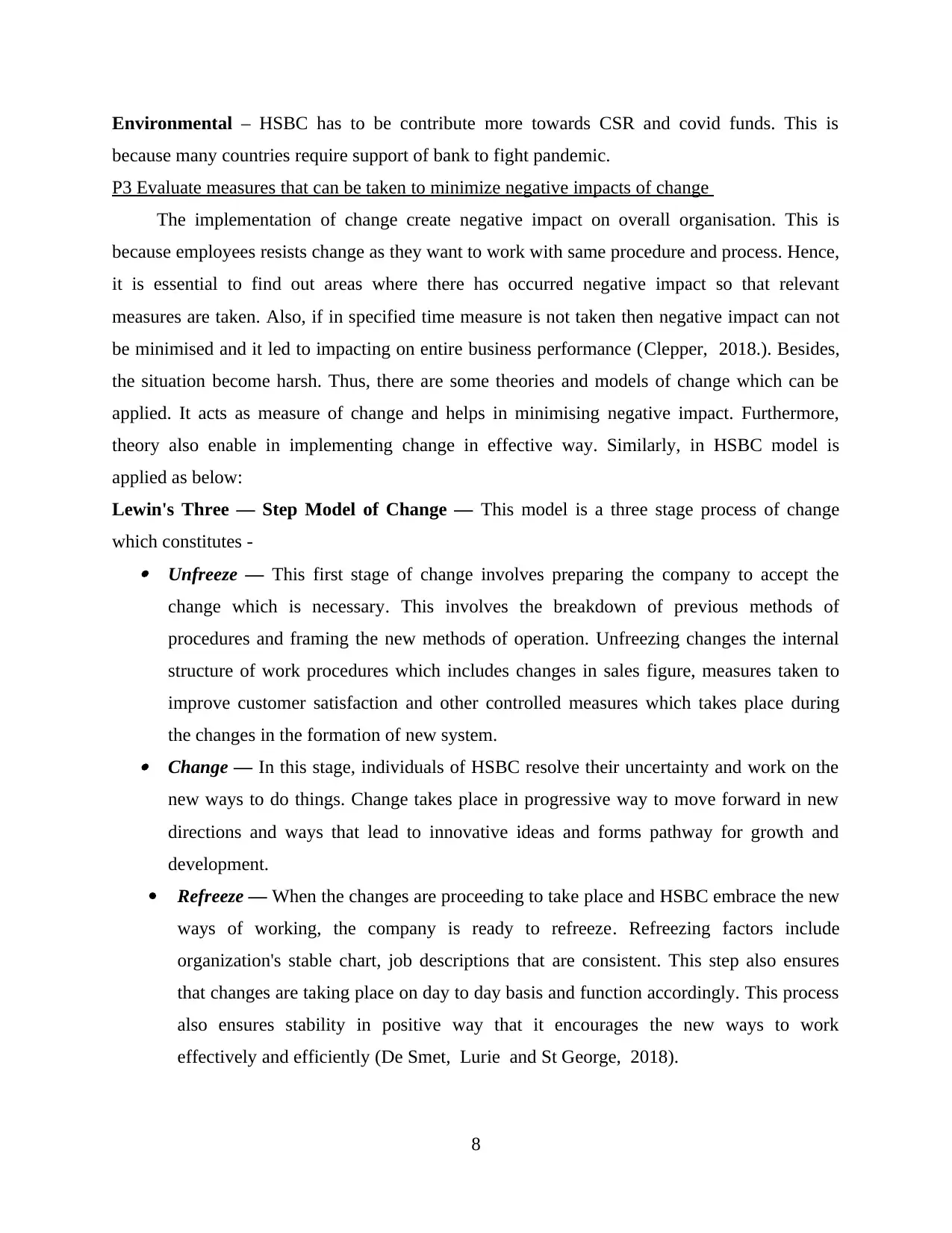
Environmental – HSBC has to be contribute more towards CSR and covid funds. This is
because many countries require support of bank to fight pandemic.
P3 Evaluate measures that can be taken to minimize negative impacts of change
The implementation of change create negative impact on overall organisation. This is
because employees resists change as they want to work with same procedure and process. Hence,
it is essential to find out areas where there has occurred negative impact so that relevant
measures are taken. Also, if in specified time measure is not taken then negative impact can not
be minimised and it led to impacting on entire business performance (Clepper, 2018.). Besides,
the situation become harsh. Thus, there are some theories and models of change which can be
applied. It acts as measure of change and helps in minimising negative impact. Furthermore,
theory also enable in implementing change in effective way. Similarly, in HSBC model is
applied as below:
Lewin's Three — Step Model of Change — This model is a three stage process of change
which constitutes - Unfreeze — This first stage of change involves preparing the company to accept the
change which is necessary. This involves the breakdown of previous methods of
procedures and framing the new methods of operation. Unfreezing changes the internal
structure of work procedures which includes changes in sales figure, measures taken to
improve customer satisfaction and other controlled measures which takes place during
the changes in the formation of new system. Change — In this stage, individuals of HSBC resolve their uncertainty and work on the
new ways to do things. Change takes place in progressive way to move forward in new
directions and ways that lead to innovative ideas and forms pathway for growth and
development.
Refreeze — When the changes are proceeding to take place and HSBC embrace the new
ways of working, the company is ready to refreeze. Refreezing factors include
organization's stable chart, job descriptions that are consistent. This step also ensures
that changes are taking place on day to day basis and function accordingly. This process
also ensures stability in positive way that it encourages the new ways to work
effectively and efficiently (De Smet, Lurie and St George, 2018).
8
because many countries require support of bank to fight pandemic.
P3 Evaluate measures that can be taken to minimize negative impacts of change
The implementation of change create negative impact on overall organisation. This is
because employees resists change as they want to work with same procedure and process. Hence,
it is essential to find out areas where there has occurred negative impact so that relevant
measures are taken. Also, if in specified time measure is not taken then negative impact can not
be minimised and it led to impacting on entire business performance (Clepper, 2018.). Besides,
the situation become harsh. Thus, there are some theories and models of change which can be
applied. It acts as measure of change and helps in minimising negative impact. Furthermore,
theory also enable in implementing change in effective way. Similarly, in HSBC model is
applied as below:
Lewin's Three — Step Model of Change — This model is a three stage process of change
which constitutes - Unfreeze — This first stage of change involves preparing the company to accept the
change which is necessary. This involves the breakdown of previous methods of
procedures and framing the new methods of operation. Unfreezing changes the internal
structure of work procedures which includes changes in sales figure, measures taken to
improve customer satisfaction and other controlled measures which takes place during
the changes in the formation of new system. Change — In this stage, individuals of HSBC resolve their uncertainty and work on the
new ways to do things. Change takes place in progressive way to move forward in new
directions and ways that lead to innovative ideas and forms pathway for growth and
development.
Refreeze — When the changes are proceeding to take place and HSBC embrace the new
ways of working, the company is ready to refreeze. Refreezing factors include
organization's stable chart, job descriptions that are consistent. This step also ensures
that changes are taking place on day to day basis and function accordingly. This process
also ensures stability in positive way that it encourages the new ways to work
effectively and efficiently (De Smet, Lurie and St George, 2018).
8
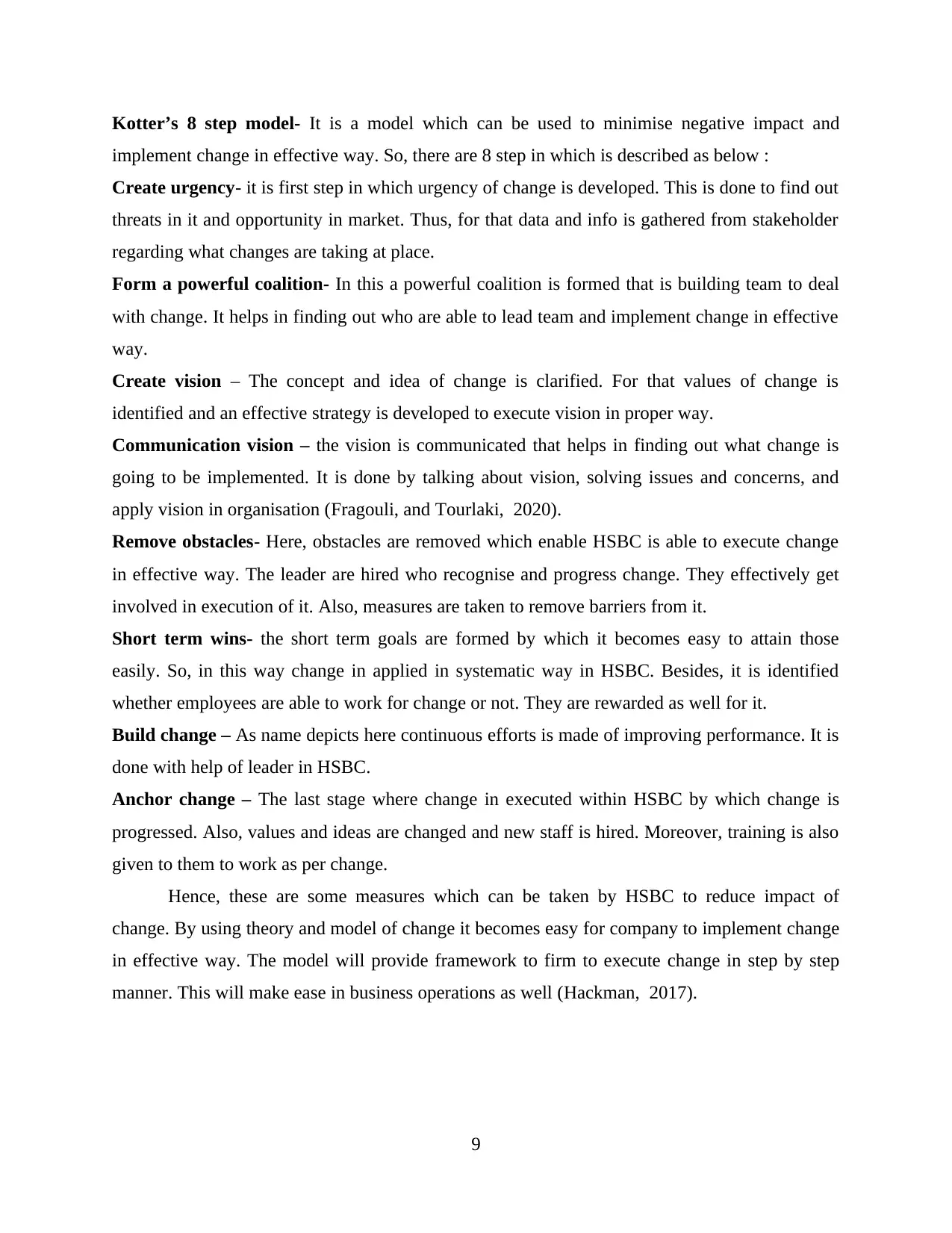
Kotter’s 8 step model- It is a model which can be used to minimise negative impact and
implement change in effective way. So, there are 8 step in which is described as below :
Create urgency- it is first step in which urgency of change is developed. This is done to find out
threats in it and opportunity in market. Thus, for that data and info is gathered from stakeholder
regarding what changes are taking at place.
Form a powerful coalition- In this a powerful coalition is formed that is building team to deal
with change. It helps in finding out who are able to lead team and implement change in effective
way.
Create vision – The concept and idea of change is clarified. For that values of change is
identified and an effective strategy is developed to execute vision in proper way.
Communication vision – the vision is communicated that helps in finding out what change is
going to be implemented. It is done by talking about vision, solving issues and concerns, and
apply vision in organisation (Fragouli, and Tourlaki, 2020).
Remove obstacles- Here, obstacles are removed which enable HSBC is able to execute change
in effective way. The leader are hired who recognise and progress change. They effectively get
involved in execution of it. Also, measures are taken to remove barriers from it.
Short term wins- the short term goals are formed by which it becomes easy to attain those
easily. So, in this way change in applied in systematic way in HSBC. Besides, it is identified
whether employees are able to work for change or not. They are rewarded as well for it.
Build change – As name depicts here continuous efforts is made of improving performance. It is
done with help of leader in HSBC.
Anchor change – The last stage where change in executed within HSBC by which change is
progressed. Also, values and ideas are changed and new staff is hired. Moreover, training is also
given to them to work as per change.
Hence, these are some measures which can be taken by HSBC to reduce impact of
change. By using theory and model of change it becomes easy for company to implement change
in effective way. The model will provide framework to firm to execute change in step by step
manner. This will make ease in business operations as well (Hackman, 2017).
9
implement change in effective way. So, there are 8 step in which is described as below :
Create urgency- it is first step in which urgency of change is developed. This is done to find out
threats in it and opportunity in market. Thus, for that data and info is gathered from stakeholder
regarding what changes are taking at place.
Form a powerful coalition- In this a powerful coalition is formed that is building team to deal
with change. It helps in finding out who are able to lead team and implement change in effective
way.
Create vision – The concept and idea of change is clarified. For that values of change is
identified and an effective strategy is developed to execute vision in proper way.
Communication vision – the vision is communicated that helps in finding out what change is
going to be implemented. It is done by talking about vision, solving issues and concerns, and
apply vision in organisation (Fragouli, and Tourlaki, 2020).
Remove obstacles- Here, obstacles are removed which enable HSBC is able to execute change
in effective way. The leader are hired who recognise and progress change. They effectively get
involved in execution of it. Also, measures are taken to remove barriers from it.
Short term wins- the short term goals are formed by which it becomes easy to attain those
easily. So, in this way change in applied in systematic way in HSBC. Besides, it is identified
whether employees are able to work for change or not. They are rewarded as well for it.
Build change – As name depicts here continuous efforts is made of improving performance. It is
done with help of leader in HSBC.
Anchor change – The last stage where change in executed within HSBC by which change is
progressed. Also, values and ideas are changed and new staff is hired. Moreover, training is also
given to them to work as per change.
Hence, these are some measures which can be taken by HSBC to reduce impact of
change. By using theory and model of change it becomes easy for company to implement change
in effective way. The model will provide framework to firm to execute change in step by step
manner. This will make ease in business operations as well (Hackman, 2017).
9
⊘ This is a preview!⊘
Do you want full access?
Subscribe today to unlock all pages.

Trusted by 1+ million students worldwide
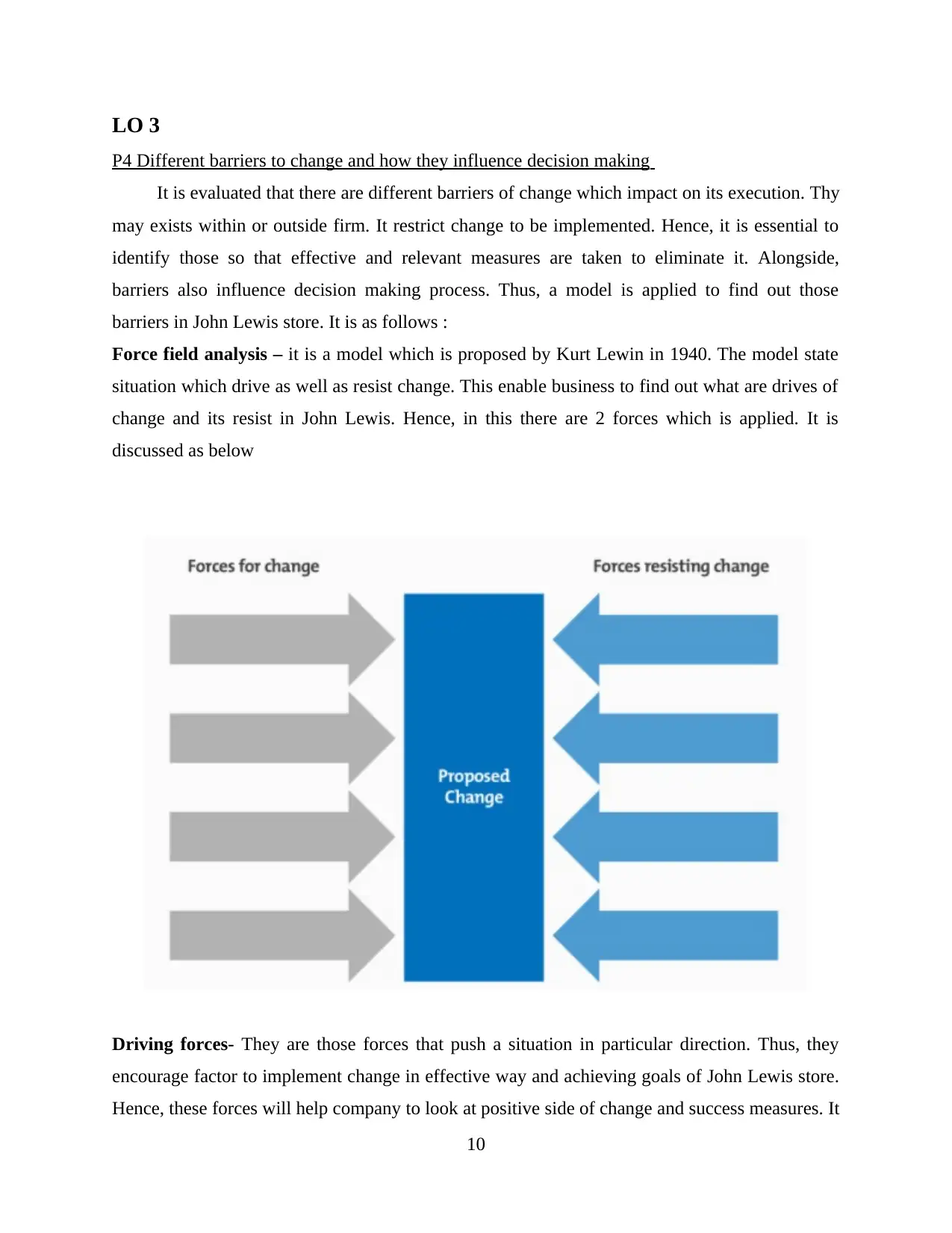
LO 3
P4 Different barriers to change and how they influence decision making
It is evaluated that there are different barriers of change which impact on its execution. Thy
may exists within or outside firm. It restrict change to be implemented. Hence, it is essential to
identify those so that effective and relevant measures are taken to eliminate it. Alongside,
barriers also influence decision making process. Thus, a model is applied to find out those
barriers in John Lewis store. It is as follows :
Force field analysis – it is a model which is proposed by Kurt Lewin in 1940. The model state
situation which drive as well as resist change. This enable business to find out what are drives of
change and its resist in John Lewis. Hence, in this there are 2 forces which is applied. It is
discussed as below
Driving forces- They are those forces that push a situation in particular direction. Thus, they
encourage factor to implement change in effective way and achieving goals of John Lewis store.
Hence, these forces will help company to look at positive side of change and success measures. It
10
P4 Different barriers to change and how they influence decision making
It is evaluated that there are different barriers of change which impact on its execution. Thy
may exists within or outside firm. It restrict change to be implemented. Hence, it is essential to
identify those so that effective and relevant measures are taken to eliminate it. Alongside,
barriers also influence decision making process. Thus, a model is applied to find out those
barriers in John Lewis store. It is as follows :
Force field analysis – it is a model which is proposed by Kurt Lewin in 1940. The model state
situation which drive as well as resist change. This enable business to find out what are drives of
change and its resist in John Lewis. Hence, in this there are 2 forces which is applied. It is
discussed as below
Driving forces- They are those forces that push a situation in particular direction. Thus, they
encourage factor to implement change in effective way and achieving goals of John Lewis store.
Hence, these forces will help company to look at positive side of change and success measures. It
10
Paraphrase This Document
Need a fresh take? Get an instant paraphrase of this document with our AI Paraphraser
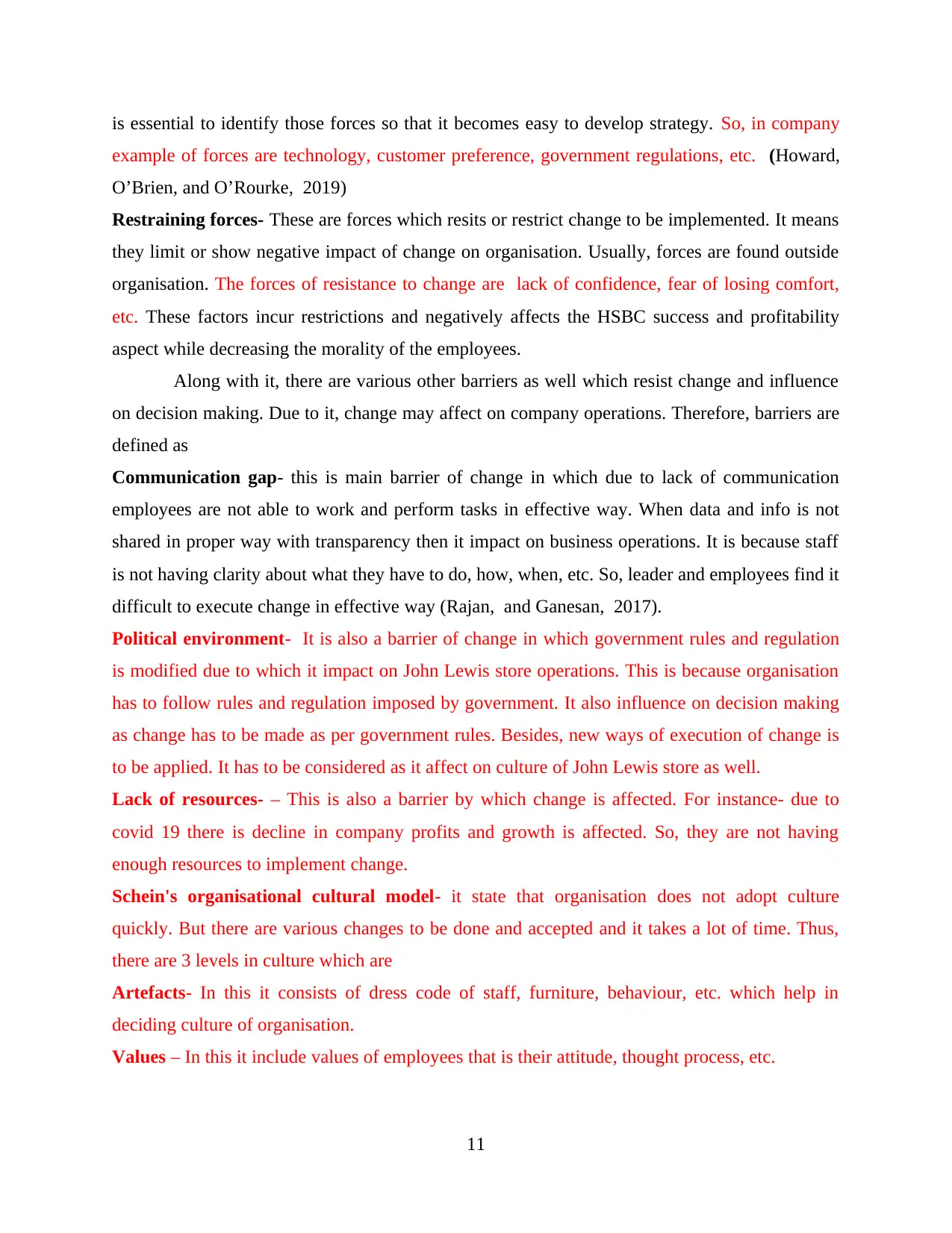
is essential to identify those forces so that it becomes easy to develop strategy. So, in company
example of forces are technology, customer preference, government regulations, etc. (Howard,
O’Brien, and O’Rourke, 2019)
Restraining forces- These are forces which resits or restrict change to be implemented. It means
they limit or show negative impact of change on organisation. Usually, forces are found outside
organisation. The forces of resistance to change are lack of confidence, fear of losing comfort,
etc. These factors incur restrictions and negatively affects the HSBC success and profitability
aspect while decreasing the morality of the employees.
Along with it, there are various other barriers as well which resist change and influence
on decision making. Due to it, change may affect on company operations. Therefore, barriers are
defined as
Communication gap- this is main barrier of change in which due to lack of communication
employees are not able to work and perform tasks in effective way. When data and info is not
shared in proper way with transparency then it impact on business operations. It is because staff
is not having clarity about what they have to do, how, when, etc. So, leader and employees find it
difficult to execute change in effective way (Rajan, and Ganesan, 2017).
Political environment- It is also a barrier of change in which government rules and regulation
is modified due to which it impact on John Lewis store operations. This is because organisation
has to follow rules and regulation imposed by government. It also influence on decision making
as change has to be made as per government rules. Besides, new ways of execution of change is
to be applied. It has to be considered as it affect on culture of John Lewis store as well.
Lack of resources- – This is also a barrier by which change is affected. For instance- due to
covid 19 there is decline in company profits and growth is affected. So, they are not having
enough resources to implement change.
Schein's organisational cultural model- it state that organisation does not adopt culture
quickly. But there are various changes to be done and accepted and it takes a lot of time. Thus,
there are 3 levels in culture which are
Artefacts- In this it consists of dress code of staff, furniture, behaviour, etc. which help in
deciding culture of organisation.
Values – In this it include values of employees that is their attitude, thought process, etc.
11
example of forces are technology, customer preference, government regulations, etc. (Howard,
O’Brien, and O’Rourke, 2019)
Restraining forces- These are forces which resits or restrict change to be implemented. It means
they limit or show negative impact of change on organisation. Usually, forces are found outside
organisation. The forces of resistance to change are lack of confidence, fear of losing comfort,
etc. These factors incur restrictions and negatively affects the HSBC success and profitability
aspect while decreasing the morality of the employees.
Along with it, there are various other barriers as well which resist change and influence
on decision making. Due to it, change may affect on company operations. Therefore, barriers are
defined as
Communication gap- this is main barrier of change in which due to lack of communication
employees are not able to work and perform tasks in effective way. When data and info is not
shared in proper way with transparency then it impact on business operations. It is because staff
is not having clarity about what they have to do, how, when, etc. So, leader and employees find it
difficult to execute change in effective way (Rajan, and Ganesan, 2017).
Political environment- It is also a barrier of change in which government rules and regulation
is modified due to which it impact on John Lewis store operations. This is because organisation
has to follow rules and regulation imposed by government. It also influence on decision making
as change has to be made as per government rules. Besides, new ways of execution of change is
to be applied. It has to be considered as it affect on culture of John Lewis store as well.
Lack of resources- – This is also a barrier by which change is affected. For instance- due to
covid 19 there is decline in company profits and growth is affected. So, they are not having
enough resources to implement change.
Schein's organisational cultural model- it state that organisation does not adopt culture
quickly. But there are various changes to be done and accepted and it takes a lot of time. Thus,
there are 3 levels in culture which are
Artefacts- In this it consists of dress code of staff, furniture, behaviour, etc. which help in
deciding culture of organisation.
Values – In this it include values of employees that is their attitude, thought process, etc.
11
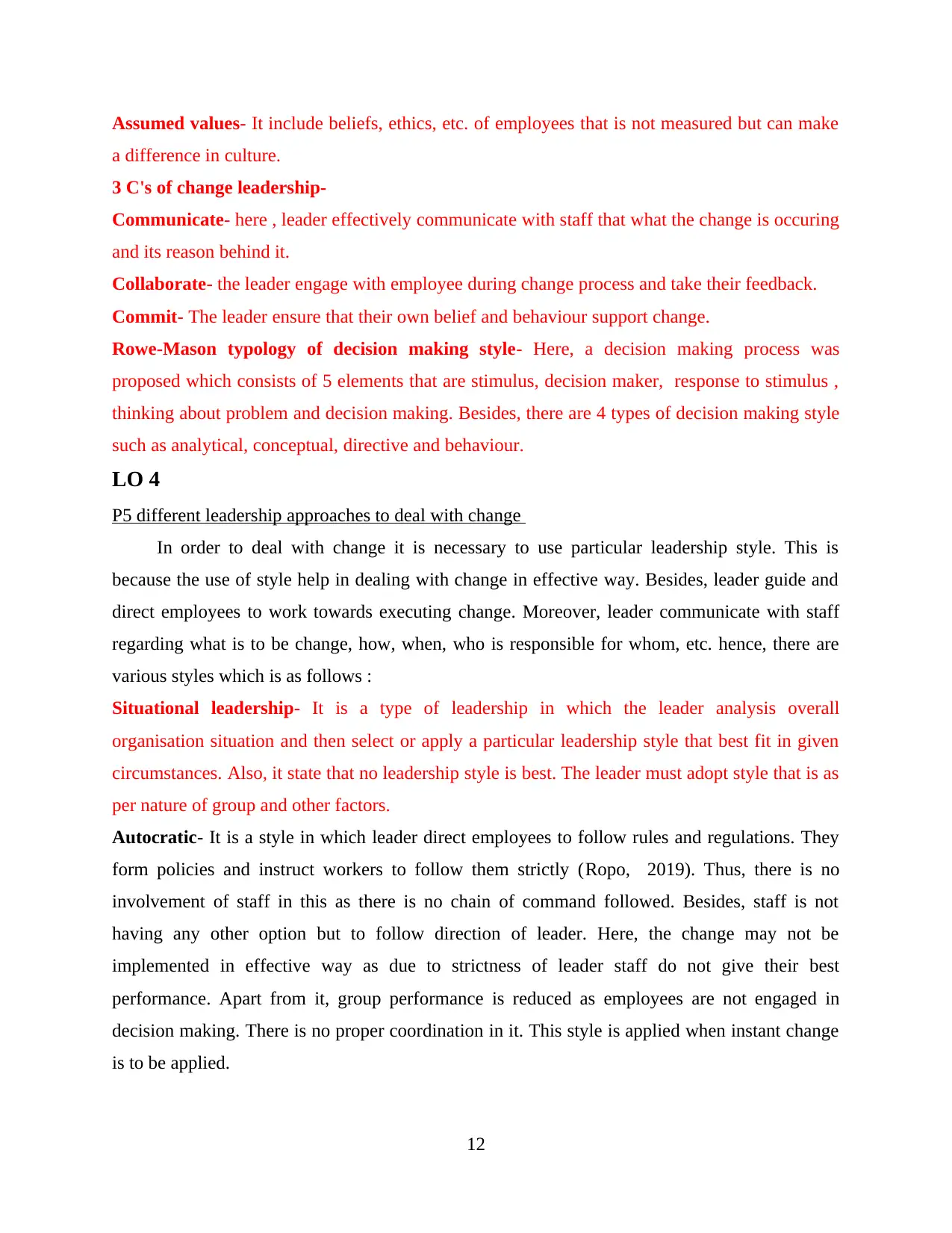
Assumed values- It include beliefs, ethics, etc. of employees that is not measured but can make
a difference in culture.
3 C's of change leadership-
Communicate- here , leader effectively communicate with staff that what the change is occuring
and its reason behind it.
Collaborate- the leader engage with employee during change process and take their feedback.
Commit- The leader ensure that their own belief and behaviour support change.
Rowe-Mason typology of decision making style- Here, a decision making process was
proposed which consists of 5 elements that are stimulus, decision maker, response to stimulus ,
thinking about problem and decision making. Besides, there are 4 types of decision making style
such as analytical, conceptual, directive and behaviour.
LO 4
P5 different leadership approaches to deal with change
In order to deal with change it is necessary to use particular leadership style. This is
because the use of style help in dealing with change in effective way. Besides, leader guide and
direct employees to work towards executing change. Moreover, leader communicate with staff
regarding what is to be change, how, when, who is responsible for whom, etc. hence, there are
various styles which is as follows :
Situational leadership- It is a type of leadership in which the leader analysis overall
organisation situation and then select or apply a particular leadership style that best fit in given
circumstances. Also, it state that no leadership style is best. The leader must adopt style that is as
per nature of group and other factors.
Autocratic- It is a style in which leader direct employees to follow rules and regulations. They
form policies and instruct workers to follow them strictly (Ropo, 2019). Thus, there is no
involvement of staff in this as there is no chain of command followed. Besides, staff is not
having any other option but to follow direction of leader. Here, the change may not be
implemented in effective way as due to strictness of leader staff do not give their best
performance. Apart from it, group performance is reduced as employees are not engaged in
decision making. There is no proper coordination in it. This style is applied when instant change
is to be applied.
12
a difference in culture.
3 C's of change leadership-
Communicate- here , leader effectively communicate with staff that what the change is occuring
and its reason behind it.
Collaborate- the leader engage with employee during change process and take their feedback.
Commit- The leader ensure that their own belief and behaviour support change.
Rowe-Mason typology of decision making style- Here, a decision making process was
proposed which consists of 5 elements that are stimulus, decision maker, response to stimulus ,
thinking about problem and decision making. Besides, there are 4 types of decision making style
such as analytical, conceptual, directive and behaviour.
LO 4
P5 different leadership approaches to deal with change
In order to deal with change it is necessary to use particular leadership style. This is
because the use of style help in dealing with change in effective way. Besides, leader guide and
direct employees to work towards executing change. Moreover, leader communicate with staff
regarding what is to be change, how, when, who is responsible for whom, etc. hence, there are
various styles which is as follows :
Situational leadership- It is a type of leadership in which the leader analysis overall
organisation situation and then select or apply a particular leadership style that best fit in given
circumstances. Also, it state that no leadership style is best. The leader must adopt style that is as
per nature of group and other factors.
Autocratic- It is a style in which leader direct employees to follow rules and regulations. They
form policies and instruct workers to follow them strictly (Ropo, 2019). Thus, there is no
involvement of staff in this as there is no chain of command followed. Besides, staff is not
having any other option but to follow direction of leader. Here, the change may not be
implemented in effective way as due to strictness of leader staff do not give their best
performance. Apart from it, group performance is reduced as employees are not engaged in
decision making. There is no proper coordination in it. This style is applied when instant change
is to be applied.
12
⊘ This is a preview!⊘
Do you want full access?
Subscribe today to unlock all pages.

Trusted by 1+ million students worldwide
1 out of 15
Related Documents
Your All-in-One AI-Powered Toolkit for Academic Success.
+13062052269
info@desklib.com
Available 24*7 on WhatsApp / Email
![[object Object]](/_next/static/media/star-bottom.7253800d.svg)
Unlock your academic potential
Copyright © 2020–2025 A2Z Services. All Rights Reserved. Developed and managed by ZUCOL.




